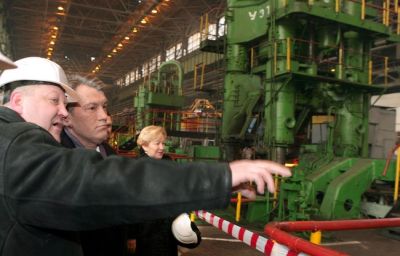Caught Between Two Worlds – Ukraine’s Defense Industry
Military Structure Reforms
Creating a defense industry that meets Ukraine’s military needs also depends upon reforms within the country’s military force structure – attempts to match defense industry organization and output to the country’s armed forces actual requirements are futile until the military structure’s end-state is determined. This represents another area in which Ukraine is caught between two worlds: the old Soviet era Cold War force structure focusing on homeland defense by a large, conscript army; and a new vision that seeks to integrate a smaller, better trained, professionally competent, Ukrainian “expeditionary†force structure within a western European “collective security†framework. Misaligned force structure and money are two major obstacles to such reform.
{default}Ukraine’s military forces still show too many senior officers in proportion to junior officers. Colonels and Lt. Colonels vastly outnumber Captains and Lieutenants by a large majority. At the non-commissioned officer (NCO) level, sergeants that provide the critical first-line troop leadership suffer from the lingering Soviet legacy of lack of training and professional schooling. Without a well-trained, professionally competent NCO corps, Ukraine’s military forces cannot achieve long term effectiveness. The problem that plagued USSR military forces (i. e. a large officer corps presiding over a larger pool of inadequately trained conscripts with no real professional NCO core in between) continues in Ukraine’s military. Officer to enlisted ratio is 1:2.6 (i. e. about one officer for every 3 enlisted personnel, more than twice the rate found in western military forces). In the U. S. armed forces, for example, the ratio is 1:5.2. Government imposed restrictions on the military manpower pool also inhibits inducting highly-qualified personnel (91-percent of the potential manpower pool is exempt from military service; as a result, 66-percent of inductees do not have a secondary school education).

President of the Ukraine, Viktor Yushchenko visits a factory in Dnipropetrovsk, February 27, 2007.
Ukraine’s military education system also needs drastic overhaul, although there is some good news in this area. Ukrainian leadership now recognizes diplomas from courses their officers have completed in the U.S., Canada and the U.K. One also hopes that Ukraine is endeavoring to send its “best and brightest†to these courses. In the immediate post-Cold War era, the officers sent by Russia and some of the former Soviet republics tended to be those selected for political reliability rather than those who showed promise of achieving high ranks (and it did not help the situation when Russia’s first student at the U. S. Army War College defected!). In 2004, president Yushchenko appointed two reform-minded U. S. war college graduates to key positions: Defense Minister Gritsenko (Air War College graduate) and First Deputy Defense Minister Polyarkov (Army War College graduate).
Starvation Diet
Hobbling defense reform efforts is the near starvation diet that has characterized Ukraine’s defense spending. Its current military strength is 280,000, yet even the planned reduction to a force of 180,000 to 200,00 may not be economically feasible. Prior to 2002, Ukraine allotted only 1.3-percent of its Gross Domestic Product (GDP) to defense spending (the U. S. currently commits about 4-percent of GDP to defense; during Vietnam, this was 9-percent; during the Reagan “build up†years, the figure was 7-percent; the figure “bottomed out†immediately following the end of the Cold War at 3-percent). In 2002 that was raised slightly to 2.2-percent of GDP, but money problems continue to plague Ukraine’s defense establishment and retard needed reform. Ukraine ranks 3d of 26 among NATO member and partnership countries in size of armed forces, but falls to only 127 of 156 worldwide in expenditure per serviceman. In 2006, Ukraine spent only 16 Euros per service member, while figures for other countries show: US=1,190; France=453; and Italy=235. Ukraine’s defense budget also shows another serious roadblock to modernizing and reforming its armed forces – inflated personnel costs. In the 2004 defense budget, 85-percent was slated for personnel costs, while only fractions were targeted for the crucial areas of procurement (3-percent), R&D (2-percent), and training (just 1-percent).
Moreover, simply budgeting for this defense outlay does not ensure that Ukraine’s armed forces will actually receive the slated amount. In 2003, the budget covered only 75-percent of the actual needs of Ukraine’s armed forces, yet they only received actual money to cover 70-percent of needs. From 2000-2004, this under-funding was from 30 to 60-percent. How does the defense establishment make up for the shortfall? Commanders often “rent out†their troops for civilian labor projects and for private security, and they clandestinely sell off arms and equipment. How much of this “military black market†cash actually ends up in the commanders’ pockets is a matter of speculation (as in the Soviet Union, defense information in Ukraine is still treated like a “state secret,†preventing public knowledge and input into the process).
[continued on next page]

